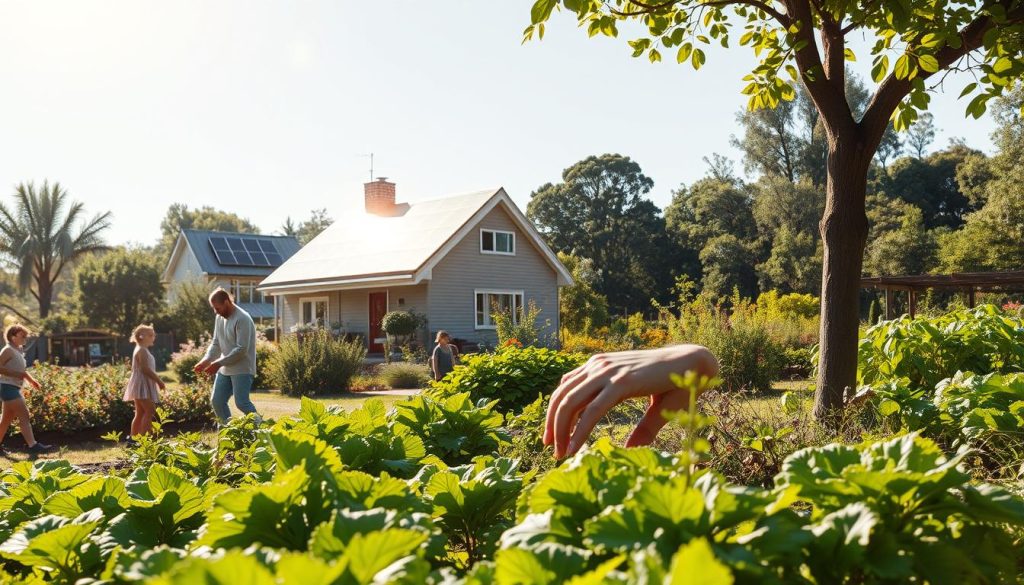Our world is moving faster than ever. Every choice we make today shapes tomorrow’s planet. From morning coffee cups to evening energy use, these decisions matter more than we realize.
The connection between our daily habits and Earth’s health runs deeper than most people think. When we choose sustainable products or reduce waste, we create ripples of positive change. These small actions add up to make real differences in our communities.
Conscious Living starts with understanding this powerful link. Your personal choices about food, transportation, and home organization directly affect air quality and natural resources. This journey toward better living doesn’t require perfect changes overnight.
Smart shifts in daily routines can boost both your well-being and environmental health. Whether you’re taking first steps or deepening existing habits, small changes create lasting impact. Ready to discover how your choices can build a better future?
Understanding the Connection Between Lifestyle and Environment
Every choice we make affects the world around us. From turning on the lights in the morning to going to bed at night, our actions impact air quality, water, and wildlife. This link between our habits and the environment is always there, even if we can’t see it.
Knowing this connection gives us the power to make a difference. When we choose fair trade coffee or drive less, we see our impact. This makes living green not just about giving up things, but about making smart choices for ourselves and the planet.

The Concept of Sustainable Living
Sustainable living is about living now without harming the future. It’s more than just recycling or using energy-efficient bulbs. It’s a whole new way of thinking about how we use resources.
At its heart, sustainable living means using less, reusing more, and recycling what we must. These actions help reduce our impact on the environment while keeping our lives comfortable and convenient.
Starting a sustainable lifestyle doesn’t mean changing everything at once. Simple steps like buying local food, using less plastic, or walking short distances can make a big difference. These changes can also improve our health, build community, and save money.
Urban vs. Rural Lifestyle Choices
Urban and rural areas offer different chances and challenges for living sustainably. Cities have public transport, shared gardens, and energy-saving homes. These can greatly reduce our carbon footprint compared to suburban areas.
But cities also have their own hurdles. Higher consumption, less space for gardening, and less connection to nature can make some green practices harder. City folks often rely on packaged foods and finding fresh, local produce can be tough.
Rural areas have a closer bond with nature and more room for sustainable living. Many rural folks already live sustainably due to necessity, like preserving food, fixing things instead of buying new, and using natural resources wisely.
Both cities and rural areas have their own ways to live sustainably. Success comes from finding green practices that fit your life, rather than trying to follow a single approach.
The Role of Technology in Modern Living
Technology has changed how we live, making it easier to be eco-friendly. It helps us track our environmental impact and make better choices. From smart homes to apps, tech connects our daily lives to green practices.
These tech advancements benefit the planet and our wallets. Smart devices learn our habits to save energy and money. They make our homes more comfortable and efficient.
Smart Homes and Energy Efficiency
Smart home tech is a big step forward in saving energy. Intelligent thermostats can cut heating and cooling costs by up to 23% a year. They adjust based on when you’re home or away.
Smart bulbs also save energy. They dim or turn off when not needed. Some even change color to help you sleep better.

Devices that track energy use show how much power you’re using. They help spot waste and track your carbon footprint. Many people cut their bills by 10-15% by using these tools.
Smart water systems also help save water. Leak detectors and smart irrigation adjust watering based on weather and soil moisture.
Apps for Sustainable Living and Environment
Apps make living sustainably easy and fun. Carbon tracking apps show your daily impact. They offer tips to reduce it.
Shopping apps connect you with local, eco-friendly stores. Some even check the environmental impact of products before you buy.
Apps make going green a game. You can set goals, earn points, and compete with friends. This makes adopting eco-friendly habits more fun.
Transport apps help you find the best way to get around. They suggest routes and modes of transport to reduce car use.
Impact of Diet Choices on the Environment
Every meal is a chance to care for our planet. What we eat affects water, air, and land around the world. Knowing this helps us choose food that’s good for us and the Earth.
Agriculture is a big source of greenhouse gases, making up nearly 30% of emissions. Livestock farming takes up 70% of farmland but only gives us 18% of our food. This shows how important our food choices are for the planet.
Plant-based Diets and Their Benefits
Choosing plant-based meals is great for the environment. Studies say these diets can cut our carbon footprint by up to 50%. They also need less water and land than meat-based diets.
Going green with your diet doesn’t mean you can’t eat meat. Even small changes help a lot. Try these easy swaps:
- Replace beef with chicken or fish twice a week
- Use plant-based proteins like beans, lentils, and tofu
- Choose local, seasonal veggies
- Use plant-based milk instead of dairy
These changes can make you healthier and help the planet. Plant-based foods are full of fiber, vitamins, and antioxidants, unlike processed meats.

Reducing Food Waste: Simple Steps
Food waste is a big problem. About one-third of all food globally ends up in landfills. There, it produces methane, a gas 25 times worse than carbon dioxide.
Reducing waste at home is key to mindful consumption. Smart planning and storage can greatly reduce waste. Here are some tips:
- Plan meals before you shop
- Keep fruits and veggies fresh longer
- Get creative with leftovers
- Compost food scraps instead of throwing them away
- Buy only what you need and check expiration dates
These steps can save you money and help the planet. The average American family throws away $1,500 in food each year. Cutting down on waste puts that money back in your pocket.
Supporting local farmers and eating seasonal produce also helps. Buying from farmers markets gets you fresh food and supports your community. Knowing how food packaging affects the environment helps you make better choices too.
Transportation and Its Environmental Effects
The way we travel affects our health and the planet. Transportation is responsible for nearly 30% of greenhouse gas emissions in the U.S. It’s a key area for reducing our carbon footprint.
Every trip we take has an environmental impact. Cars with just one person inside pollute the most. But, using shared transport can greatly reduce our impact. Our travel choices also affect the air quality around us.
Knowing these links helps us make better choices. Small changes in how we travel can make a big difference. These changes can also save us money and improve our health.
Eco-Friendly Commuting Options
Public transport is a top choice for reducing carbon footprint. Buses and trains can cut emissions by up to 85% compared to driving alone. Cities are expanding their transit systems to make it easier to use.
Active transport like walking and biking is even better. They produce no emissions and are great exercise. They’re best for short trips and can replace many car rides.
Here are some eco-friendly commuting tips:
- Use public transit for longer trips
- Bike or walk for trips under two miles
- Carpool with coworkers or neighbors
- Work from home when you can
- Combine errands into one trip
Car-sharing programs offer flexibility without the cost of owning a car. They reduce the need for vehicles in communities. Many people find they don’t need to own a car to get around.
The Rise of Electric Vehicles
Electric vehicles are a big step towards cleaner transport. Battery tech has improved a lot lately. Charging stations are getting more common, making electric cars practical for daily use.
The green benefits of electric cars depend on the power source. In areas with clean energy, they produce much fewer emissions. As clean energy grows, so will these benefits.
Electric cars help reduce carbon footprint in many ways. They cut emissions in cities and boost demand for clean energy. Many owners pair their cars with solar panels for even more benefits.
Costs for electric cars are dropping fast. They’re now cheaper to run than gas cars. Incentives from the government and states make them more affordable for families.
Mental Health and Environmental Awareness
Caring for our environment and our mental health are closely linked. This connection is at the heart of conscious living. It shows how taking care of ourselves and the planet go together. Studies reveal that spending time in nature lowers stress and boosts mental health.
Modern life often pulls us away from nature. This can make us feel anxious, depressed, and disconnected. But, when we reconnect with nature, our minds clear and stress drops.

Nature’s Impact on Well-being
Being in nature has clear benefits for our mental health. Research shows that just a short time in green spaces can lower stress and improve mood. The Japanese practice of forest bathing is a great example of how nature can be therapeutic.
Simple actions can make a big difference in our lives. Here are some natural wellness activities:
- Taking short walks in local parks during lunch breaks
- Caring for houseplants or small indoor gardens
- Eating meals outdoors when weather permits
- Opening windows to let fresh air circulate indoors
- Listening to natural sounds like rain or birds
These activities create a positive cycle. Feeling better mentally motivates us to protect our environment. This strengthens our commitment to living consciously.
Mindfulness and Outdoor Activities
Mindfulness and outdoor activities are powerful for mental wellness. Practicing mindfulness in nature deepens our connection to the environment. This connection often leads to more sustainable choices.
Outdoor mindfulness activities offer many mental health benefits:
- Meditation in gardens or parks reduces anxiety and improves focus
- Hiking on local trails provides exercise and stress relief
- Outdoor yoga combines physical activity with nature connection
- Gardening offers therapeutic benefits through hands-on earth contact
These practices help us see ourselves as part of nature, not separate. This perspective fosters a sense of responsibility and care. It encourages us to make choices that support our mental health and the environment.
Regular outdoor mindfulness activities lead to lasting positive changes. They change how we relate to our environment and ourselves.
Community Initiatives for a Sustainable Future
Creating a sustainable future needs everyone’s help. Communities all over America are working together to protect our planet. These efforts show how local actions can lead to big environmental changes.
Local Solutions: Community Gardens
Community gardens turn empty lots into green spaces. Cities like Detroit and Portland have seen great success. These gardens cut down on food transport emissions and give fresh produce to neighborhoods.
They also teach families about growing food sustainably. This improves air quality and helps local wildlife. People get to know their food sources and neighbors better.
Environmental Education Programs
Environmental education programs teach kids to care for the planet. Schools work with groups like the National Wildlife Federation. Libraries host workshops on waste reduction and energy saving.
These programs encourage people to make eco-friendly choices. They teach the importance of choosing products that are good for the environment. Community centers offer classes on renewable energy and water conservation.
These efforts help communities change for the better. They show that small actions can make a big difference when we work together.

